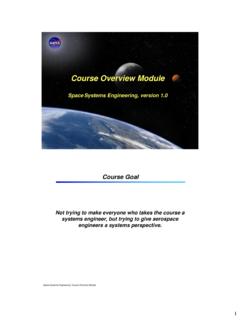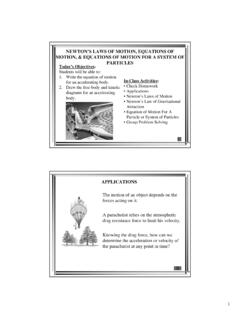Transcription of RELATIVE MOTION ANALYSIS: VELOCITY
1 RELATIVE MOTION analysis : VELOCITY . Today's Objectives: Students will be able to: 1. Describe the VELOCITY of a rigid body in terms of translation and rotation components. In-Class Activities: 2. Perform a RELATIVE - MOTION Applications VELOCITY analysis of a point on the Translation and Rotation body. Components of VELOCITY RELATIVE VELOCITY analysis Group Problem Solving APPLICATIONS. As the slider block A moves horizontally to the left with vA, it causes the link CB to rotate counterclockwise. Thus vB is directed tangent to its circular path. Which link is undergoing general plane MOTION ? How can its angular VELOCITY , , be found?
2 1. APPLICATIONS. (continued). Planetary gear systems are used in many automobile automatic transmissions. By locking or releasing different gears, this system can operate the car at different speeds. How can we relate the angular velocities of the various gears in the system? RELATIVE MOTION analysis . (Section ). When a body is subjected to general plane MOTION , it undergoes a combination of translation and rotation. =. Point A is called the base point in this analysis . It generally has a known MOTION . The x'-y' frame translates with the body, but does not rotate. The displacement of point B can be written: Disp.
3 Due to translation drB = drA + drB/A. Disp. due to translation and rotation Disp. due to rotation 2. RELATIVE MOTION analysis : VELOCITY . = +. The VELOCITY at B is given as : (drB/dt) = (drA/dt) + (drB/A/dt) or vB = vA + vB/A. Since the body is taken as rotating about A, vB/A = drB/A/dt = x rB/A. Here will only have a k component since the axis of rotation is perpendicular to the plane of translation. RELATIVE MOTION analysis : VELOCITY . (continued). vB = vA + x rB/A. When using the RELATIVE VELOCITY equation, points A and B. should generally be points on the body with a known MOTION . Often these points are pin connections in linkages.
4 Here both points A and B have circular MOTION since the disk and link BC move in circular paths. The directions of vA and vB are known since they are always tangent to the circular path of MOTION . 3. RELATIVE MOTION analysis : VELOCITY . (continued). vB = vA + x rB/A. When a wheel rolls without slipping, point A is often selected to be at the point of contact with the ground. Since there is no slipping, point A has zero VELOCITY . Furthermore, point B at the center of the wheel moves along a horizontal path. Thus, vB has a known direction, , parallel to the surface. PROCEDURE FOR analysis . The RELATIVE VELOCITY equation can be applied using either a Cartesian vector analysis or by writing scalar x and y component equations directly.
5 Scalar analysis : 1. Establish the fixed x-y coordinate directions and draw a kinematic diagram for the body. Then establish the magnitude and direction of the RELATIVE VELOCITY vector vB/A. 2. Write the equation vB = vA + vB/A and by using the kinematic diagram, underneath each term represent the vectors graphically by showing their magnitudes and directions. 3. Write the scalar equations from the x and y components of these graphical representations of the vectors. Solve for the unknowns. 4. PROCEDURE FOR analysis . (continued). Vector analysis : 1. Establish the fixed x-y coordinate directions and draw the kinematic diagram of the body, showing the vectors vA, vB, rB/A and.
6 If the magnitudes are unknown, the sense of direction may be assumed. 2. Express the vectors in Cartesian vector form and substitute into vB = vA + x rB/A. Evaluate the cross product and equate respective i and j components to obtain two scalar equations. 3. If the solution yields a negative answer, the sense of direction of the vector is opposite to that assumed. EXAMPLE. Given: Block A is moving down at 2 m/s. Find: The VELOCITY of B at the instant = 45 . Plan: 1. Establish the fixed x-y directions and draw a kinematic diagram. 2. Express each of the VELOCITY vectors in terms of their i, j, k components and solve vB = vA + x rB/A.
7 5. EXAMPLE. (continued). Solution: vB = vA + AB x rB/A. vB i = -2 j + ( k x ( sin 45 i - cos 45 j )). vB i = -2 j + sin 45 j + cos 45 i Equating the i and j components gives: vB = cos 45. 0 = -2 + sin 45. Solving: = rad/s or AB = rad/s k vB = 2 m/s or vB = 2 m/s i EXAMPLE II. Given:Collar C is moving downward with a VELOCITY of 2 m/s. Find: The angular velocities of CB. and AB at this instant. Plan: Notice that the downward MOTION of C causes B to move to the right. Also, CB and AB both rotate counterclockwise. First, draw a kinematic diagram of link CB and use vB = vC. + CB x rB/C. (Why do CB first?) Then do a similar process for link AB.
8 6. EXAMPLE II. (continued). Solution: Link CB. Write the RELATIVE - VELOCITY equation: vB = vC + CB x rB/C. vB i = -2 j + CB k x ( i - j ). vB i = -2 j + CB j + CB i By comparing the i, j components: i: vB = CB => vB = 2 m/s i j: 0 = -2 + CB => CB = 10 rad/s k EXAMPLE II. (continued). Link AB experiences only rotation about A. Since vB is known, there is only one equation with one unknown to be found. vB = AB x rB/A. 2 i = AB k x ( j ). 2 i = AB i By comparing the i-components: 2 = AB. So, AB = 10 rad/s k 7. GROUP PROBLEM SOLVING. Given: The crankshaft AB is rotating at 500 rad/s about a fixed axis passing through A.
9 Find: The speed of the piston P at the instant it is in the position shown. Plan: 1) Draw the kinematic diagram of each link showing all pertinent VELOCITY and position vectors. 2) Since the MOTION of link AB is known, apply the RELATIVE VELOCITY equation first to this link, then link BC. GROUP PROBLEM SOLVING. Solution: (continued). 1) First draw the kinematic diagram of link AB. AB. B rB/A A. Link AB rotates about a fixed axis at . A. Since AB is ccw, vB will be 100 mm y directed down, so vB = -vB j. vB. x Applying the RELATIVE VELOCITY equation with vA = 0: vB = vA + AB x rB/A. -vB j = (500 k) x ( i + 0 j).
10 -vB j = -50 j + 0 i Equating j components: vB = 50. vB = -50 j m/s 8. GROUP PROBLEM SOLVING. (continued). 2) Now consider link BC. C Since point C is attached to the vC piston, vC must be directed up or 500 mm BC rC/B down. It is assumed here to act y down, so vC = -vC j. The unknown B sense of BC is assumed here to be vB x ccw: BC = BC k. Applying the RELATIVE VELOCITY equation: vC = vB + BC x rC/B. -vC j = -50 j + ( BC k) x ( cos60 i + sin60 j). -vC j = -50 j + BC j BC i i: 0 = BC => BC = 0. j: -vC = -50 + BC => vC = 50. vC = -50 j m/s INSTANTANEOUS CENTER OF ZERO VELOCITY . Today's Objectives: Students will be able to: 1.










